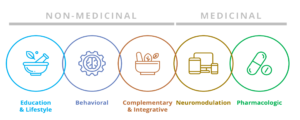Carl Cincinnato
Benjamin Franklin was the first to say an ounce of prevention is worth a pound of cure. In a year when we’ve all seen new ways to prevent migraine attacks before they start, we’ll explore just how important prevention is and who needs it most. Discover how you can combine preventive therapies for the greatest relief; when to stop, when to start, and when to switch your approach.
Dr. Anna Andreou is a multi-award-winning researcher, headache specialist and neurophysiologist. She is the director of headache research at The Headache Center, Guy’s and St. Thomas’ NHS Trust and Wolfson CARD and King’s College London.
What are the differences between acute therapies and preventive therapies for migraine?
Dr. Andreou: “First of all, we separate these different treatments into acute and preventive because they have different aims. The acute treatment aims to stop the migraine attack and relieves the acute pain that a patient suffers during the onset of a migraine attack. When it comes to the prevention treatment, the aim there is different. The aim with prevention is to actually reduce the frequency of the attacks, reduce the severity and the duration of the attacks. Obviously it’s not for everyone. So for example, if a patient has one migraine a month, maybe they can cope with just the acute treatment. But if the migraine attacks are more frequent or more complicated, the patient needs to consider preventive treatments as an option.
“There is no strict guideline in terms of when a patient should start a preventive treatment. What we try to say to our patients is that if the migraine is severe enough and frequent enough to affect your daily life, to affect how you concentrate at work, and if you are taking too many acute treatments, too many painkillers, then a preventive treatment is a good option for you. In actual practice that means two migraine attacks that last about three days each, if remain untreated, that can be disabling enough for a patient to consider having a migraine preventive treatment.”
How does a physician decide where to start with a patient if it’s determined that they do need some kind of preventive?
Dr. Andreou: “We are guided by guidelines. In the U.K. we have NICE, the regulatory body that publishes the guidelines in terms of migraine prevention, and there we have the first-line choices, second-line choices, and then guidelines on when to start using more procedure-like treatments, like Botox or CGRP antibodies. So, I mentioned before that the first-line treatments are topiramate and propranolol. Then, second- line treatment is amitriptyline and acupuncture, actually. And then there are guidelines in terms of when to start Botox, and I guess we’re going to have guidelines on when to start the CGRP antibodies.”
Can a combination of pharmaceuticals, neuromodulation devices, and alternative or natural treatments be synergistic in migraine treatment?
Dr. Andreou: “You can combine some treatments from different classes. It depends on the individual, on the side effects profile, and of other comorbidities. One of the best options, actually, is to combine one of the preventives with a different type of preventive treatment, like cognitive behavioral treatment, acupuncture, relaxation techniques; some dietary supplements may also be effective, and the neuromodulation devices. In our practice, we have a psychologist that the patients can consult about their treatment and also about their migraine as a disease. Essentially, with them, the psychologist will have their own personalized plan in terms of understanding their disease, appreciating the effect the disease has, but also the expectations a patient has from their treatment and from their consultants or in terms of the treatment plan they have for them in the future.”
Watch the full interview to find out:
Why are medications developed for other conditions, such as hypertension and epilepsy, helpful in migraine prevention?
What are some of the neuromodulation devices available and how can they help with migraine prevention?
How effective has Botox proven to be as a migraine preventive?
How do the anti-CGRP treatments compare to the other “off-label” preventive treatments that have been around longer, such as Botox, topiramate, and propranolol?
How effective are supplements such as magnesium, riboflavin, butterbur, and feverfew in migraine prevention?
Is it recommended or even possible to combine two preventive pharmaceuticals, such as Botox and CGRP treatments?
How long does a patient need to be on a particular preventive treatment therapy or approach before they can determine if it’s working?
What are the guidelines for preventive therapies based on migraine frequency, i.e., for patients with high frequency versus low frequency per month?
Watch Dr. Anna Andreou’s interview preview here or order it as part of the Migraine World Summit package from this page.
If you previously purchased the 2019 Migraine World Summit, you are all set to login to watch the full interview.
Posted in: Migraine Education





